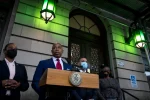By Ronnette A. Cox | November 13, 2020
Election workers can never be fully prepared for what issues might arise on Election Day. But one question to always expect is how to fill out the ballot itself. For many people, presidential elections are the only times they vote, and over the four years in between, they often forget how the process works.
In New York, this can be particularly confusing since the ballot options are listed vertically, with the candidates’ names listed horizontally. A common issue is people filling out the ballot from left to right, rather than top to bottom, which results in them accidentally voting for two people for one position, effectively voiding their ballot and requiring them to fill out a new one.
On Election Day, poll workers in Brownsville found themselves answering this familiar question, explaining to groups of voters how to mark their ballots to avoid this issue properly. A police officer, one of two posted at the site, overheard and immediately jumped to the conclusion that the worker was telling the people who to vote for, falsely accusing her of electioneering within earshot of the voters.
I witnessed the dramatic aftermath of this erroneous, politically-motivated accusation. After refusing to listen to the poll worker’s explanation, the officers on-site needlessly called in more armed officers. Their unnecessary escalation of events led to an influx of NYPD officers and officials on-site—with a total of five officers assembling in front of and four others inside the polling site. Several officials arrived to needlessly investigate and remove the poll site coordinator (the person in charge of the site) in front of people casting their ballots, intimidating other workers and voters in an overwhelmingly Black community, threatened by a crowded police presence.
This outrageous incident is just one example of abusive policing that the NYPD engaged in leading up to and on Election Day. In the days before Nov. 3, police officers unlawfully seized masks and fliers on COVID-19 prevention from community organizers attempting to provide nonpartisan voter assistance outside of a polling location. Other uniformed officers used their patrol car loudspeaker to endorse Trump unlawfully. On Election Day, in Brooklyn, an officer threatened to illegally arrest a Brooklyn man wearing a “Black Lives Matter” shirt for standing too close to the polls, falsely claiming that he was making a political statement. Voters at multiple poll sites across the city reported a higher, more visible police presence, leading to an unnecessarily intimidating voting experience for some. All of these unnecessary—and some illegal—actions by NYPD officers undermine democracy.
Many people and organizations raised concerns about police interference leading up to the election. In response, Communities United for Police Reform (CPR) Action Fund launched #CopWatchThePolls, a nonpartisan short-term effort asking voters to share information, photos, and videos related to NYPD misconduct at voting sites. This effort encouraged the community to keep a watchful eye and hold the department accountable when no one else would.
It’s time for New York to take meaningful steps towards preventing the NYPD’s interference with democracy. The Police Benevolent Association, New York City’s largest police union, publicly endorsed Trump and spent more than $1 million to sway the 2020 elections in their favor. Alongside this clear political bias, the NYPD’s behavior before and on Nov. 3 raises questions on how we can expect officers to truly protect the democratic rights of all New Yorkers, especially Black, Latinx, and other New Yorkers of color.
As the results of the presidential and local elections came in, people across the country celebrated poll workers as crucial players protecting our democracy. What we saw in Brownsville was an all-too-common occurrence of a dangerous and suppressive police force abusing its power and standing in the way of democratic participation. As new leaders take office in New York and across the country, it’s time we all come together to envision a new way of public safety that supports democratic participation, not suppresses it.
Ronnette A. Cox is a Board of Elections Assembly District monitor and is a staffer with Communities United for Police Reform Action Fund.
Read Source


